¶ Introduction
The initial approach segment is the segment of an instrument approach procedure between the initial approach fix (IAF) and the intermediate fix (IF). The initial approach segment begins at the initial approach fix (IAF) and ends at the intermediate fix (IF).
In the initial approach segment, the aircraft has left the en-route structure and it is entering the Instrument approach procedure.
Aircraft speed and configuration will depend on the distance from the aerodrome and the descent required.
The initial approach segment provides at least 300m (1000ft) of obstacle clearance in the primary area.
Normally track guidance is provided along the initial approach segment to the IF with a maximum angle of interception of 90° for a precision approach and 120° for a non-precision approach.
Sometimes there is no suitable IAF or IF in the procedure in order to have an initial approach segment respecting all construction restrictions. Sometimes IF does not exist and the initial approach segment ends with FAF or FAP.
In some cases, a specific pattern or manoeuvre can be prescribed on this segment like:
- Shuttle
- Dead reckoning segment
- Racetrack
- Reversal procedure
- Radar vectoring segment
¶ Bank angle and speed restrictions
This procedure is based on an average achieved bank angle of 25°, or the bank angle giving a rate of turn of 3° per second whichever is less.
The speeds must not be exceeded to ensure that the aircraft remains within the limits of the protected areas.
¶ Descent
The aircraft shall cross the fix or facility and fly outbound on the specified track descending as necessary to the procedure altitude but no lower as the minimum crossing altitude associated with that segment.
If the descent is specified after the inbound turn, this descent shall not be started until the aircraft is established on the inbound track (racetrack or reversal procedure).
¶ Wind effect
To achieve a stabilized approach, the aircraft shall compensate both heading and timing parameters for the effects of wind in order to regain the inbound track as accurately and expeditiously as possible.
The wind value can be estimated, calculated or given by meteorological reports.
¶ Shuttle
A shuttle is a decent or climb conducted in a holding pattern.
A shuttle is normally prescribed where the descent required between the end of the initial approach and the beginning of the final approach exceeds the values shown in the table below.
The table shows minimum descent rates specified on a shuttle, reversal or race track procedure.
| Outbound track | Maximum | Minimum |
|---|---|---|
| Category A and B | 245 m/min (804 ft/min) | Not applicable |
| Category C, D and E | 365 m/min (1197 ft/min) | Not applicable |
| Category H | 365 m/min (1197 ft/min) | Not applicable |
| Outbound track | Maximum | Minimum |
| Category A and B | 200 m/min (655 ft/min) | 120 m/min (394ft/min) |
| Category C, D and E | 305 m/min (1000 ft/min) | Not applicable |
| Category H | 230 m/min (755 ft/min) | 180 m/min (590 ft/min) |
¶ Reversal procedure
The reversal procedure may be in the form of a procedure or a base turn. The direction and timing specified should be strictly followed in order to remain within the airspace provided.
There are 3 recognized manoeuvres related to the reversal procedure:
- 45° / 180° procedure turn
- 80° / 260° procedure turn
- Base turn
An aircraft is considered established in the outbound track when it is:
- Within half full scale deflection for the ILS or VOR
- Within ±5° of the required bearing for the NDB
When a DME distance or radial/bearing is specified, it shall not be exceeded when flying on the outbound track.
¶ 45° / 180° procedure turn
This procedure turn starts at a facility and consists of:
- Straight leg with track guidance (timed leg, limited by radial, DME distance or fix)
- 45° turn (by the right or by the left)
- Straight leg without track guidance. This leg is timed 1min from the start of the turn for aircraft category A and B, 1min 15s for aircraft category C, D and E.
- 180° turn in the opposite direction to intercept the inbound track

The entry shall be a direct entry from a track within ±30° of the outbound track of the reversal procedure.
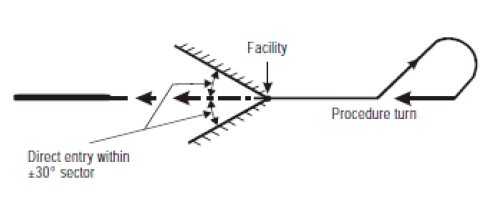
¶ 80° / 260° procedure turn
This procedure turn starts at a facility and consists of:
- Straight leg with track guidance (timed leg, limited by radial, DME distance or fix)
- 80° turn (by the right or by the left)
- 260° turn in the opposite direction to intercept the inbound track

The 80°/260° procedure turn is an alternative to the 45°/180°. The entry, speed and bank conditions are the same.
¶ Base turn
This procedure consists of:
- Specified outbound track (timed leg, limited by radial or DME distance)
- A turn to intercept the inbound track

The outbound track and/or the timing or distance may be different for the various categories of aircraft. If so, separate procedures are published.
The entry shall be a direct entry from a track within ±30° of the outbound track of the reversal procedure.
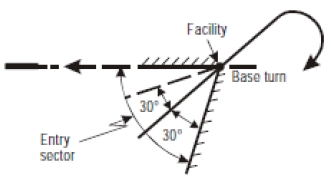
This procedure is based on an average achieved bank angle of 25°, or the bank angle giving a rate of turn of 3° per second whichever is less.
¶ Dead reckoning (DR) segment
Where an operational advantage can be obtained, an ILS may include a dead reckoning (DR) segment from a fix to the localizer. The DR track will intercept the localizer at 45° and will not be more than 19 km (10NM) in length. The point of localizer interception is the beginning of the intermediate segment.
The DR segment allows a proper ILS interception:
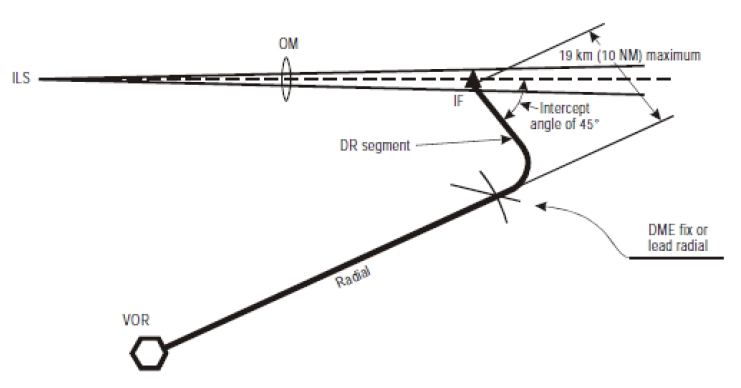
¶ Racetrack procedure
This procedure consists of:
- A 180° turn from the inbound track and from overhead the facility, navigation aid or fix, to the outbound straight track for 1, 2 or 3 minutes.
- A 180° turn in the same direction to return to the outbound track
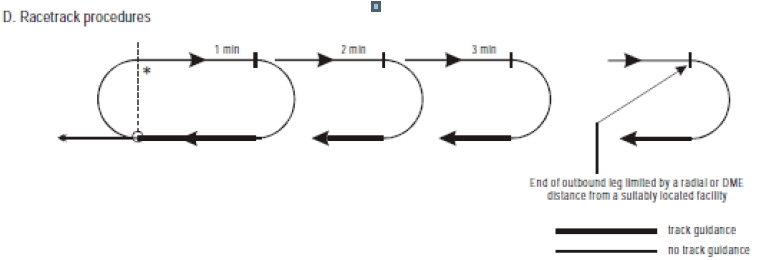
As an alternative of timing, the outbound leg may be limited by a DME distance or intersecting radial/bearing.
Racetrack procedures are used where sufficient distance is not available in a straight segment to accommodate the required loss of altitude and when entry into a reversal procedure is not practical.
The entry inside a racetrack procedure is like the holding procedure entry method:
- direct entry -- sector 3
- offset entry -- sector 2
- parallel entry -- sector 1
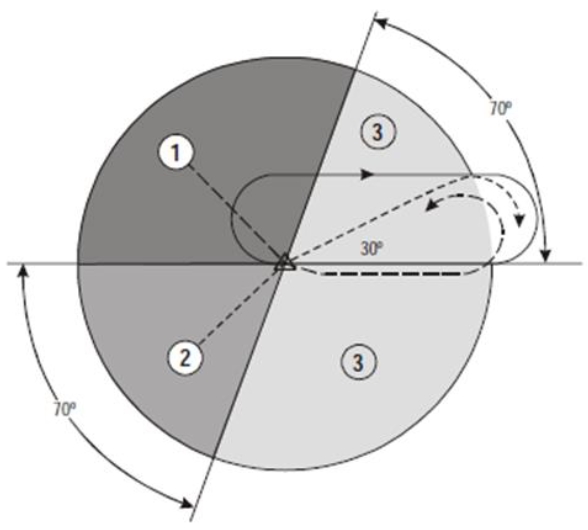
¶ Reversal procedure combined with a holding procedure
Sometimes in a reversal procedure, the aircraft will arrive from sector 2 instead of sector 1. With presence of a holding procedure at the same point, the aircraft shall enter into the holding pattern with adequate manoeuvres in order to be positioned in sector 1 to continue the procedure turn.
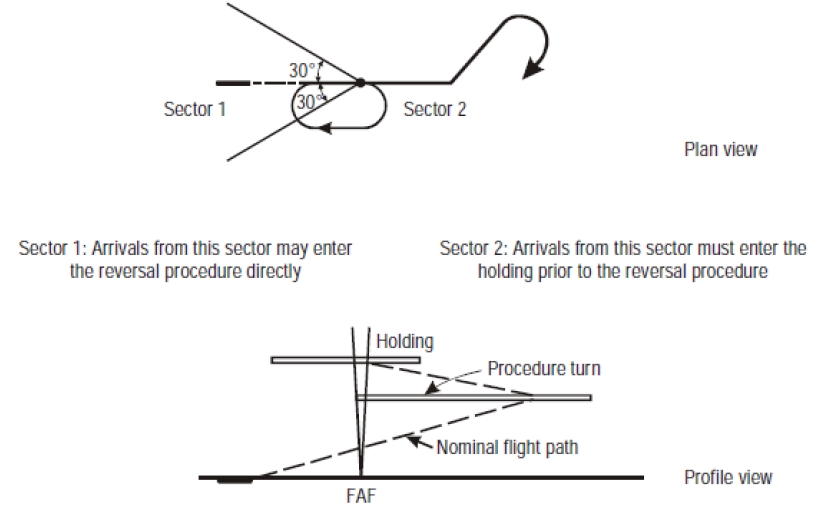
¶ Radar guidance during initial approach
Some initial approach procedures are published without any defined track after a specific fix. In these procedures, you may find 'vector' or 'radar' words in the diagram or in the description text. These procedures are mainly linked with air traffic controllers who give radar vectors during the approach in busiest areas.
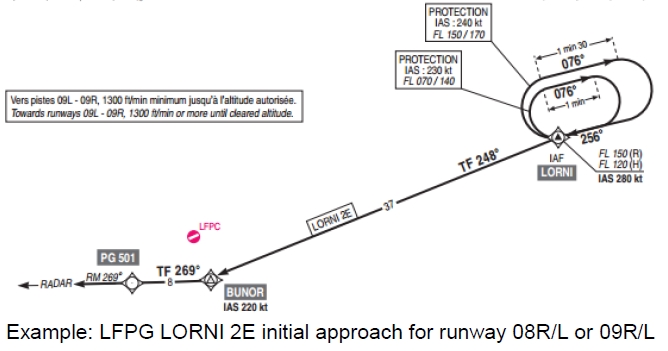
The air traffic controller has the responsibility to vector the aircraft to the final approach track at the published altitude after starting to use radar for issuing clearances and instructions.
- ICAO Documentation 8168 - Aircraft Operations - Volume I - Flight Procedures - 6th Edition 2010 - Section 4 - Chapter 3
- VID 150259 - Creation
- VID 531824 - Wiki Integration
- VID 496402 - Wiki.js integration